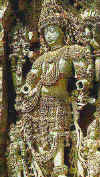
Hinduism is the religion of the majority in India. The write-up below on Hindutva explains what Hinduism is.

Hinduism is the religion of the majority in India. The write-up below on Hindutva explains what Hinduism is.
|
|
|
|
___________________________________________________________
________________________________________________
This site has been selected by Encyclopedia Britannica "as one of the best on the Internet, when reviewed for quality, accuracy of content, presentation and usability".
_____________________________________________
_____________________________________________________________
India is the birthplace of many religions, Hinduism, Buddhism, Jainism and Sikhism are all progeny of this part of our globe. But they are not the only religions that exist here. Adherents of Christianity, Islam, Zoroastrainism and Judaism also to be found in India.
Over countless generations there has been significant exchange of customs, traditions, beliefs, rituals, etc., between these different religions Such an exchange is not peculiar to India and has been occuring the world over throughout the past. In India though, the existence of many religions in the same social environment created a situation favourable for such an interchange of customs and rituals.
The other fact that some religions existing in India are offspring of the amalgam of beliefs that co-existed under the heading Hinduism. This has also led to the presence of many features of the parent religion in the offspring religions. At times this has blurred the line dividing Hinduism from the offspring religions leading occasionally to tension of the offspring religions with their parent.
One instance of this is the ire against the constitution of India wherein the term 'Hindu' includes Buddhists, Jains and Sikhs.
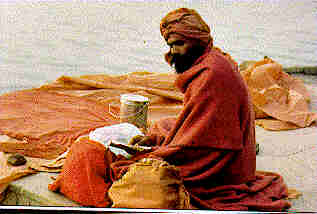 | Hinduism does not have a formal priesthood. The Sadhus are traditionally those who have renounced material pleasures of life. They along with the semi-formal Brahmin clergymen are looked upon as what can come closest to a priesthood. |
But interchange of customs and rituals has taken place even between religions originating in India and those brought into India from other parts of our globe. This interchange has also been a massive one for the reason that that apart from the fusion of customs as a result of co-existence of different forms of worship, the adherents of religions originating in other parts of the globe like Christianity and Islam are largely converts from Hinduism. This does not apply in the case of Zoroastrianism and Judaism as these two religions have tended to be insular and have jealously guarded against the entry of members of other faiths by way of conversion. But even then they display many traits which they have absorbed from other religions especially Hinduism.
Although this interchange has been quite substantial, it has not succeeded in bringing about identity in many important respects. Communal riots are still not a thinq of the past, sectarian feelings are still very much with as and there normally run counter to the spirit of nationalism and secularism. The result of this is perhaps India's having the dubious distinction of being a Secular society without a common civil code. For an appraisal of contemporary Indian society to be complete we ought to examine the nature and genesis of the different religions that exist around us, and also the extent to which they have influenced each other. To obtain an insisght into every religion, we shall briefly state the history of every religion since its inception, what it has borrowed from other faiths and what it has lent to it.
We start with the religion which is not only professed by a vast majority in India, but has also been the birthplace for many customs found in other religious communities in India.
 | Ram and Sita Shri Ram is an important diety in the Hindu Pantheon. He is considered to be a Maryada Purushottam which means a person who has a balance of all good qualities. |
HINDUISM
A student of Hinduism can be compared with one of those blind-folded wise men who set about to examine an elephant by touching it and came up with totally different ideas about what the elephant looked like, none of which were factual. Hinduism is like a multifarious ocean of beliefs and modes of worship with an indeterminate origin. It comprises within itself the most sublime philosophies and gross fetishism of all kinds of objects which are worshipped.
This is one religion with a history stretching from around the second millennium B.C.E. upto the present.
The Pantheism of Hinduism
A contemporary author has observed, "As a matter of fact orthodox Hindus have believed in every kind of theism, polytheism, and pantheism. They have worshipped any object which they prefer, or practically none. They followed any standard of morality or almost none. Yet they have been recognised as Hindus in good and regular standing as long as they have not flagrantly violated the rules of caste or for that offence been out-casted".
Educated Hindus though have rejected the primitive features and have developed a refined religion which they follow alongwith the cruder versions that resemble primitive animism followed by their rural and tribal brethren. Throughout its long history there have been many reform movements in Hinduism, the best known of which were Buddhism and Jainism in around the 6th century B.C.E. and Sikhism in the 16th century C.E. The recent reform movements such as the Brahmo Samaj, the Arya Samaj Prarthana Samaj, have been protests against ritualism and idolatory, but their membership is very small.
In other primitive religions, when a great reformer has come, the entire primitive religion has become uniform, and unified and has consequently become cohesive and monotheistic as in the case of Zoroastrianism and Islam. But in India the followers of a reformer have always been a separate sect and the old Hindu religion has continued to be the religion of a vast majority.
It is widely recognised that most elements of present day Hinduism descended from the amalgam of the religious beliefs of different people who migrated into the Indian Subcontinent over the period of the last 5000 years. The Aryans are assumed by some historians to have come into India (West Punjab) around 2000 B.C.E. and the modern day Hindusim is supposed to be an amalgam of their religious beliefs and those of the earlier peoples who reportedly were the founders of the Sindhu Saraswati valley civilization.
NOTE ON THE ARYAN INVASION THEORY (AIT)
But before we proceed further with our discussion on Hinduism, we shall digress into the ongoing debate about the AIT
The Case Against the AIT
There are conflicting theories of the origin of the Aryans regarding their geographical placement and chronology. There is one school that believes that the Aryans originated in India - hence the name Indo-Aryan or Indo-European.
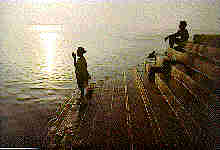 | A view of ritual bathing at one of the bathing Ghats at the Triveni Sangam at Prayaga. |
One finding that lends credence to India being the original home of the Aryans is the observations of Nakshatras (star patterns of the Zodiac) that are mentioned in the Vedas, and the Upanishads, which according to modern astronomical techniques are supposed to have existed around 7000 B.C.E. to 9000 B.C.E. This would mean that those who made those observations had not only developed the keen sense of observing and noting down what they saw in the skies, but that they lived in between 7000 B.C.E. and 9000 B.C.E. This pushes back the age of Indian civilization to a much older date than that of the Mesopotemian and Egyptian civilizations which are generally considered to be the birthplaces of human civilization.
Another finding that is used to support the idea that India is the original home of the Ayrans is the deciphering of the script of the Saraswati Sindhu valley civilization to be in fact Sanskrit. This is also used to support the theory that the founders of this civilization were in fact Sanskrit speakers. Sanskrit is the language of the Aryans. Thus if the founders of the Saraswati Sindhu Valley civilization spoke and wrote in Sanskrit, then they must be Aryans. This point is used to support the theory that India is the original home of the Aryans.
Thus it was from India, which according to this school, was the cradle of civilization, the Aryans spread all over the globe. And as India was the original home of the Aryans the AIT (Aryan Invasion Theory of India) stands disproved. But for our discussion, it is irrelevant as to where and exactly when the Aryans originated. It is sufficient to say that they followed a certain way of life in which the caste system was born in an embryonic state and then evolved to ultimately reach its present form.
The Case for the AIT
The supporters of the AIT quote the existence of legends like the Dev-Asura Sangram of the Samudra Mantan legend, the reference to the Dasa-Rajna Yuddha (Battle of kings belonging to the Dasa or Dasyu races and that of the Rajna or Aryan race). The Dasa-Rajna Yuddha has also been interpreted to mean the battle of Ten kings. Dasa meaning the figure Ten in Sanskrit.
Another issue referred to by the supporters of the AIT is the reference to the constant struggle between the Asuras, Rakshasas, Daityas and Danavas on one side with the Devas on the other. The Asuras are always portrayed in legend as attacking the settlements of the Aryans and destroying the Yagnas. This is assumed to be the struggle between the Pre-Aryans and the Aryans. The existence of finer features among the caste Hindus (especially among the Brahmins) and darker and coarser features among the scheduled castes and scheduled tribes in particular is also stated as a physical evidence of the thesis supporting the AIT, that the pre-Aryans were dark and coarse featured and the Aryans were fair. They quote the references in the Rig Veda according to which the Dasyus are referred to as being Anansa (Noseless).
Another point they quote is the reference to Indra the mythical king of the Aryans as Destroyer of Cities (Purandara), and Destroyer of Dams (Vrita-ghna). The reference to a city by the name Hariyupiya in the Rig Veda is also quoted as referring to Harrappa, where considerable archeological findings were made of the Saraswati Sindhu civilization. This is quoted to state that the Aryans were the ones who destroyed the Saraswati, Drishadvati, Sindhu civilization, before they themselves succumbed to the charm of Indian civilization and became Indianized to later on develop the classical Hindu civilization in the Ganges Valley. The struggle in the Ramayana epic between the Rakshasas led by Ravana and the king of Ayodhya Sri Rama who is helped by Pawan Putra, Hanuman the King of the Vanaras (who are said to be pre-Aryan) is said to symbolize the struggle between the Aryans and the pre-Aryan Dravidians.
 | A flower vendor outside a Hindu temple Fresh flowers, coconuts, oil, etc., are traditional offerrings made by Hindus to their various dieties. |
The "Test" of Language in Support of the AIT
Another theory that is put forth to support the AIT is that none of the spoken vernacular Indian languages are grammatically similar to Sanskrit, while they are grammatically similar to each other. This is used to infer that while the Indian vernacular languages borrow a lot from the Sanskrit vocabulary (in a simplified form), they are not derived from Sanskrit. The philological test of one language having derived from another is the similarity in grammar, the sentence structure - the protagonists of the AIT say. For example, in Sanskrit we say "Krunaavantoh Vishwam Aryam which means "We should Aryanize the World". But in none of the Indian languages is this sentence structure replicated. For example in Hindi, this would read as "Hamen Vishwa Koh Aryamay Karna Hai" and in Gujarati it would read "Aapan ney Vishwanu Aryamay Karvaanu Chey" and in Marathi it would read "Aaplyalaa Vishwaalaa Aryamaya Karaayache Ahey". The word order in the South Indian languages is also different from that of Sanskrit.
So while the different Indian vernaculars are strikingly similar to each other in their sentence structure and word order, they have no similarity with Sanskrit grammar at all, except that the individual words are borrowed from Sanskrit. Thus it is said that while almost all Indian languages (except Tamil) spoken by Hindus today have borrowed most of their vocabulary from Sanskrit, they have descended from some pre-Aryan language. This is the "claim" of those who support the AIT.
Irrelevance of the AIT
But we should underline here that both the case for the AIT and that against the AIT are based on the fallacy of racial purity. There are no pure Aryans, Dravidians, Mundas, Kushanas, Yavanas (Greeks), Shakas, Parthavas, Pahlavas, Hunas, etc in India. Indians today are a mix of all these and many more.
And why only in India, people all over the world are a result of the global melting pot. Yes there are very broad and general groupings like the Negroid, Caucasioids, Mongoloids, etc, but that is all. It is ridiculous to talk of pure races because people all over the world have interbred. What we today describe as Homo Sapien are also a mix of different evolutionary streams like the Homo Neanderthalers, Homo Erectus, Homo Ramapicthecus, etc. People all over the globe look physically different and even within small nations we find people who are physically quite different from each other. And national boundaries are just a creation of the last 200 to 300 years and these boundaries keep changing. The point is that people all over the globe over all the ages have been migrating from place to place. Hence to refer to the inhabitants of a country as being indigenous to that country is ridiculous. All over the world we the humans are made up of multi-ethnic combinations.
Hence the debate on the AIT is only of academic interest. Nothing at all changes if it is proved that the Aryans were of Indian origin within a period of say the last 5000 or 10,000 years. People all over the globe have been moving and migrating from place to place. And so nothing changes even if it is proved that at a certain time the Aryans moved from another part of our globe into India. The result of the AIT does not enhance or reduce the greatness (or otherwise) of Indian Civilization. Those who are paranoid to prove that the Aryans were invaders as far as India is concerned; or that they are indigenous to India; may well note that we the Indians today are not Aryan or Dravidian, or Munda, or Shaka, or Kushana. We are a mix of all of them and many more. And not only in India; but this is true all over the globe. Hence it is futile to link the evaluation of Indian Culture and Indian ideas with the outcome of AIT.
The author of this web page does not support or refute the AIT. Even if the Aryans came into India at some point in time some thousands of years back, the fact is that they merged into the Indian population and along with the rest contributed to Indian civilization. This kept happening with all those who came in later like the Yavanas (Greeks), Kushanas, Shakas, Hunas, etc.
The only exception was that of the coming of the Muslims who with their barrack like lifestyle and contempt for everything non-Islamic and Non-Arabic left a split in every part of the globe they overran in their Jihad.
If on the other hand the Aryans went from India to different parts of the globe, nothing changes as far as the evaluation of Indian civilization is concerned. We are concerned with the human and moral worth of Indian Ideas like Vasudaiva Kutumbakam (The World is One Family) and Ekam Sat Viprah Bahuda Vadanti (Universal Reality if One, Different people call it by Different Names). We are concerned with the actual provable achievements of ancient Indians in the fields of the physical sciences.
For our approach, the outcome of the debate on the AIT is irrelevant.
Now to continue with the nature of Hinduism, we can say that the earliest objects of worship were the forces of nature and the religion was in essence polytheistic. Later on came the personified Gods like Brahma, Vishnu and Shiva while the polytheistic nature remained unchanged.
Partial Amalgamation through the Concept of Incarnation (Avatara)
With a view to having a unifying medium, in this mushrooming pantheon, was propagated the monotheistic philosophy that there is one God, one supreme reality (Brahman) and the various personified Gods, Goddesses and animistic objects of worship are incarnations (Avataras) of God. While God himself was indestructible, the various incarnations in which he descended to Earth in the form (Rupa) of an ordinary mortal had to go through the cycle of birth and death. The incarnation idea helped to partially unify the plethora of deities as different manifestations of a single divine entity. It also facilitated the absorption of deites from other religions and tribal cults which had been outside the pale of Hinduism.
Assimilation, acculturation, amalgamation have been the hallmarks of the development and growth of the Hindu religion.
Many deities are themselves a result of amalgamation of two or more deities. For instance we have Hari-hara who is an amalgam of Hari (Krishan who is an incarnation of Vishnu) and Hara (Shiva). This amalgamation of the two recognised principal deities Vishnu and Shiva was undertaken to ease out the dualism in the Hindu religion due to the existence of the two principal sects Vaishnavism (worshippers of Vishnu) and Shaivism (worshippers of Shiva) who were frequently at loggerheads with each other. There are innumerable other sects though. Another deity who is also amalgam of Vishnu and Shiva is variously known as Sashta and Ayyappa. He has a famous shrine devoted to him at Sabarimala in Kerala.
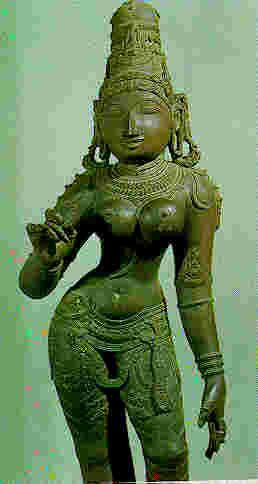 | A Goddess from the Chola period. Rajendra Chola was an ambitious ruler. Under him and under the Shailendra rulers Indians sailed to the far-east and established colonies in Java Sumatra, Bali, etc. |
The Ayyappa Mythology
The mythology behind Sastha, artfully explains this amalgam of Vishnu and Shiva. Briefly it is as follows. After a long drawn strife between Gods and demons, they mutually agreed to temporari1y sink their differences and with their combined efforts churn the ocean and draw out nectar (amrita) that existed at the bottom of the oceans. Both the Gods and demons stood on opposite sides and started the churning process with the help of Seshnaga (the celestial cobra) as a rope. The churning went on for and many beautiful and powerful things issued forth from the ocean. All these things were distributed equally between the Gods and demons. At last came the coveted nectar, but as soon I came up, the demons snatched it and ran away leaving the Gods high and dry. The Gods then prayed to lord Vishnu to retrieve their share.
To do this Vishnu struck upon an idea to deceive the demons. He took on the form of an enchanting maiden as Mohini known as the Mohini-Avatara of Vishnu. Mohini approached the demons who were having a loud argument as to how to distribute the stolen nectar amongst themselves . Taking advantage of this confusion Vishnu in the guise of Mohini offerred to distribute the nectar on condition that the nectar also be distributed amongst the Gods.
Under the captivating influence of Mohini, the demons agreed and Mohini went about distributing the nectar, first among the Gods. Very deceptively she had made the Gods and demons sit in different rows, such that when the nectar was distributed to the last God sitting there, no nectar would be left for the demons.
Now unknowing to Mohini, her seductive form had captured Shiva's imagination and later he requested Vishnu to reappear as Monini before him. Despite being warned by Vishnu that Mohini was irresistible and that Shiva would fall prey to her charms, Shiva insisted that she appear before him confident as he was of his self-control. But lust being the weakest link in the chain of instincts, on seeing the inviting forn of Mohini Shiva's self-control gave way and out of the union of Shiva and Vishnu (as Mohini) was born Sastha who is a repository of all what Shiva and Vishnu stand for.
___________________________________________________________________________________
(You have completed viewing half of this page. If you would like to have a sneak preview into the next page, before you continue viewing the rest of this page, you may roll your mouse over the frame below to see the pictures on the next page which talks about Buddhism.)
|
__________________________________________________________________________________________________________________________ _____
| |||||||||||
The script for the above applet has been written by Chintamani Thakur.
The External symbols of being a Hindu
But among the Hindus, whatever the object of worship it was personified in the form of an idol. One cannot find a Hindu temple without a idol. Propitiation of the Gods takes place through the chanting of Mantras (hymns). This is done by the officiating priest.
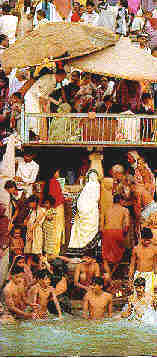 | Ritual bathing is an important custom among the Hindus. It is undertaken at every important occasion like festivals, pujas, thread ceremony, rites during all religious ceremonies,etc. Hence all important Hindu places of pilgrimage are along a river. Even most Hindu temples have a pond near them for this purpose. |
Considerable importance is attached to purification which is done by sprinkling water on an object to be purified and to the ritual washing of hands and feet before performing a prayer. Bathing in sacred rivers (notably the Ganga i.e. Ganges), is looked upon as an act of devotion that secures for a person a place in heaven . Fire plays a pivotal role in consecrating religious ceremonies, marriages, etc. The importance of fire originates in its being one of the forces of nature worshipped by the Aryans The vermilion mark on the forehead (Tilaka) alongwith the tuft of hair as the Pigtail (Shikha or Choti or Shendi) and the sacred thread (Yagnopavit or Janeu) are the external symbols that proclaim a Person's adherence to Hinduism. All these Practices are now on the wane and in urban areas they have nearly vanished.
The saffron colour is looked upon as and is to be found on flags atop temples and in the clothes worn by ascetics (Sadhus and Sanyasis). The traditional form of greeting among Hindus is the joining of hands called Namaskara.
The 4 Ashramas (Stages of life)
Traditionally, life of a person was divided into four stages viz. Brahmacharya (childhood and celibate youth), Grithasta (householder) Vanaprastha (householder devoted to spiritual pursuits) and Sanyasa (ascetic). Sanyasa has been extolled as the culmination of an ideal life. The external signs of a person on becoming a Sanyasi were the unshorn hair and beard, the growth of fingernails, the forsaking of normal ablutions.
A Sanyasi was supposed to rise above the requirements of normal material life and devoted himself to the seeking of truth Society among the Hindus has been divided into four Varnas Brahmin (clergy), Kshatriya (nobility), Vaishya (traders and cultivators) and Shudra (menials). This division is a social issue that was given religious sanctity. Belief in rebirth (Punar-janma) and release from the cycle of birth and re-birth (Moksha) have been central to Hindu morality.
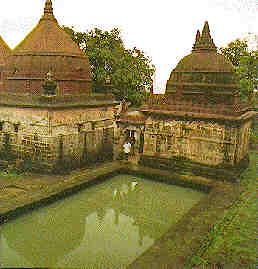 | The Parshurama Temple and the Pushkara or "Lotus Pond" which is in its precincts. Every Hindu temple has a pond near it. Devotees are supposed to take a bath before entering the temple. |
Another tradition that has been nurtured in Hinduism is that of the Guru. A Guru is supposed to play the role of a tutor and mentor. But among the Hindus, the Guru, has traditionally been considered to be more than just a tutor. Surprisingly in one Vedic hymn even Gods are referred to as Guru. (Gurur Brahma, Gurur Vishnuhu, Gururu Devoho, Maheshwaraha: Guru Sakshat Para Brahma, Tasmayee Shri Gurveh Namaha.)
Education, in India has been traditionally imparted through Gurukulas (homestead of a ,Guru). A student (Shishya) had to spend his early years at a Gurukula where he was taught all the known disciplines of knowledge. But the term Guru has also had the connotations of a spiritual guide. The term Shishya could be taken to mean both student and disciple. It has not been uncommon for a person with a spiritual bent of mind to go in search of a Guru. All spiritual personalities among the Hindus such as Swami Vivekananda, Swami Dayananda Saraswati, Swami Ramkrishna Paramhansa, etc., who attained the status of Gurus were once shishyas of some Guru. The Guru-Shishya tradition has had manifestations in innumerable Babas, Swamis and Gurus that are a part of our society, so much so that eight out of ten Indians would be followers of one Guru or another
Throughout our history, spiritual leaders and social reforms be looked upon as Gurus. In the absence of a founding father for Hinduism, these Gurus have played the role of guiding this conglomorate of beliefs (Hinduism) through the ages of history. In this context the role of Adi Shankaracharya has to be recalled.
Adi Shankaracharya's Reform of Hinduism
Adi Shankaracharya can be considered as the only Hindu spiritual leader who was almost universally accepted in this religion . His philosophical standpoints of Vedanta were effective in overshadowing Buddhism on the philosophical and intellectual level. Shankaracharya came from a Brahmin family from Kalady in Central Kerala (South India). He is sald to have lived around the 8th century C.E. In the traditional manner he seems to have had his basic education in a Gurukula (traditional monastery where education was imparted in ancient times).
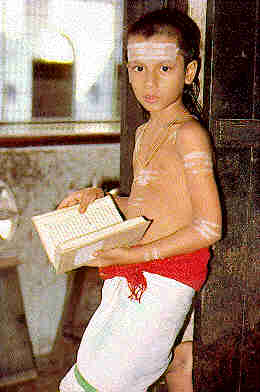 | A Shishu or Shishya (Student). Traditionally education was imparted in Ashramas and Gurukulas (monasteries). It was imparted through Shruti (hearing), Smriti (memorizing) and Sloka-Pathan (recitation). |
From his early days he displayed a passion for philosophical speculation endless debates. Completion of primary education in the Gurukula did not satisfy his thirst for knowledge. While still in his teens he set out to explore the various centers of learning.
His quest took him to north India where in one of the innumerable Buddhist monasteries, the philosophy of that religion caught his fancy and he spoke about this idea amongst his disciples and friends. One of Shankaracharya's disciples expressed readiness to enroll as a student in the Nalanda University, which in those days was the leading senter for Buddhist philosophical speculation. But being a Brahmin by birth, Shakaracharya's disciple was refused admission. Undaunted by this the young monk upon a bold idea to gain entry into the Buddhist cloister. He shaved off the tuft of hair and pigtail, cast aside his sacred thread, wiped the ash (Bhasma) on his forehead, and dressed as a Buddhist monk he approached the Nalanda University again to be enrolled in a philosophy that had fired his imagination.
Having secured admission this way, he stayed on for a few years and mastered Buddhist philosophy. Steeled as he was in the rival Hindu schools of philosophy, he beset his tutors with incisive questions many of which exposed the weaker side of Buddhist philosophy.
And day-by-day the master-philosophers at Nalanda began to grow suspicious of this curious student and henceforth they never let go an opportunity to cross-examine him. During one such grueling session Shankaracharya's disciple inadvertently slipped up and that cost him his identity (as a Buddhist monk) and very nearly his life.
The infuriated Buddhist Bhikkus (monks) caught hold of this imposter and threw him out of a window. Unfortunately for Shankaracharya's disciple, this meeting was in progress in one of the top floors of the multi-storied buildinqs of the Nalanda University. Realizing the peril he was in, whi1e falling to the ground, the disciple invoked the Vedas and cried out "If the Vedas are true not a single hair of mine will be hurt". He fortunately survived the fall but one eye of his was brutally injured and gave him a severe pain. Knowing that with this event his life as a Buddhist monk has ended, he decided to return to his Guru Adi Shankaracharya. After he returned to his Gurukula, he asked Shankaracharya one question that had been bothering him lately. He wondered why his eye had been injured when he had invoked the Vedas.
Shankaracharya explained this anomaly by telling him that he had said "If the Vedas are true not a single hair of mine w111 be hurt.", thereby he had not expressed confidence in the power of the Vedas to protect him but had expressed a hope which entertained doubts as to the power of the Vedas. Shankaracharya told him that had he said, "The Vedas are true and they will protect me", he would have come out unhurt.
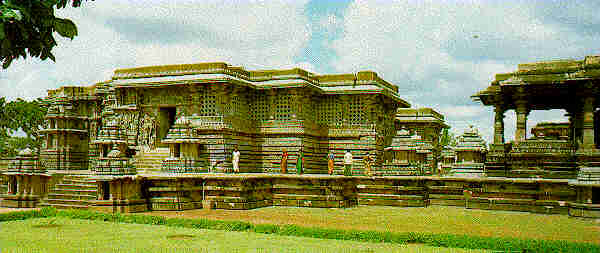 | The Halebid temple complex at Halebid in Karnataka has been built by the Hoysalas in the 12th century. The architecture here represents the finesse of craftsmanship in granite. |
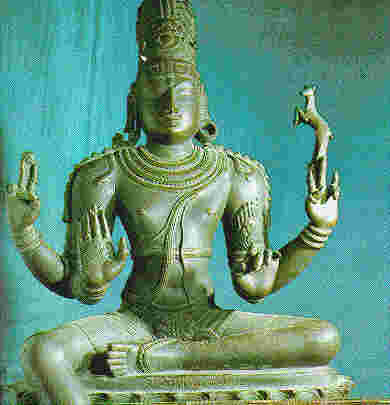 | Shiva-Maheshwara A Chola Bronze image of Shiva-Maheshwara Although this image of Shiva looks quite like Vishnu, we may observe the serpent around his neck, which establishes that this Vishnu look-alike image is in fact of Shiva-Mashewara - who sports snakes around his neck. The Cholas ruled Tamil Nadu in around the 9th century C.E. |
Sects within Hinduism made up this "Religion"
But in spite of this reform by Adi Shankaracharya, the centrifugal looseness inherent in Hinduism left no check on the innumerable sects with various objects and forms of worship that kept on mushrooming. What held the various sects together was the inclusion the principal deities like Brahma, Vishnu, Shiva, and the mother Goddess (Shakti) in the various sects, albeit in varying forms and the mutual recognition between the different sects of the validity of each other's patron deities (Ishta-devata).
Thus worshippers of Vishnu did not generally castigate the deities Shiva and Shakti as non-Hindu nor did the worshippers of Shiva look upon Vishnu as alien deity.
Some Sects broke off from Hinduism
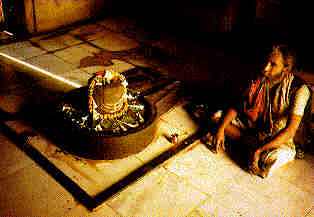 | A Shaivaite Sadhu worshipping the lingam i.e. a phallus, symbolizing the diety Shiva. |
But at times some of the sects withdrew this recognition given to the deities of other sects and acquired an exclusionist character. Jainism, Buddhism and Sikhism are surviving examples of such sects.
But on the whole the main body of beliefs that are brought under the heading Hinduism continued to be supple. On many occasions when it came into contact with alien forms of worship, it tried to incorporate them within itself.
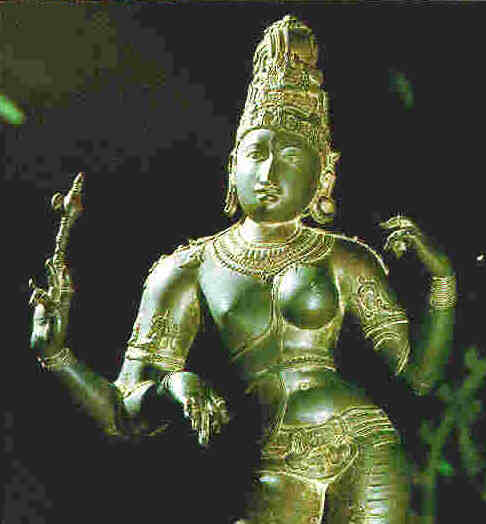 | Ardha-Nareeshwara - This image reflects the fusion of the male principle with the female principle. Or the fusion of Purusha (the male principle) with Prikriti (the female principle). This concept is an important element of Hindu Cosmogony. But Ardha-Nareeshwara is not popularly worshipped. The popularly worshipped form is of Shakti - the Mother Goddess. |
One of the offspring sects, Sikhism originated as a fusion of elements of Hinduism and Islam. During the 18tb century the formation of the Bramho Samaj in Bengal under Raja Rammohan Roy aimed at combining the best elements of Western Christianity and Hinduism. Despite the picture of ultra-orthodoxy that Hinduism normally presents, distinctly non-Hindu concepts were absorbed into it. One of these is the concept of 'Niraakar Ishwar' the formless God* it found its reflection in some Hindu sects notably the Arya Samaj which is looked upon as a revivalist movement. The Arya Samaj upholds Vedic ritualism and disowns idol worship. The influence of Islamic ideas of God (Allah) being an abstract power, on some strains of Hindu thought cannot be ruled out.
Even in day-to-day life, Hindus adhere to many practices which originate in other religions. For instance the practice among Hindus, especially among women, of covering their head while offering prayers is a result of Mohammedan influence and is an adaptation of the Mohammedan practices of wearing Burkha, Chador and observing Purdah. So is the practice of burning incense sticks (Agarbattis and Dhoop) in temples which comes form the (originally Zoroastrian) Muslim practice of burning Loban. In ancient times women in India did not follow the custom of wearing a veil.
Thus Hinduism which is the religion of the majority in India has imbibed many concepts and beliefs from the religions it came into contact with. This is more relevant in the context of Hinduism and Hindu culture being regarded largely, exclusively and distinctly Indian. What we know as the Hindu religion has been born and bred in India. Not surprisingly are the terms Indian and Hindu considered as synonymous. It is a widely held opinion that Hinduism is the heart and soul of the Indian nation. Remove Hinduism and India loses its identity.
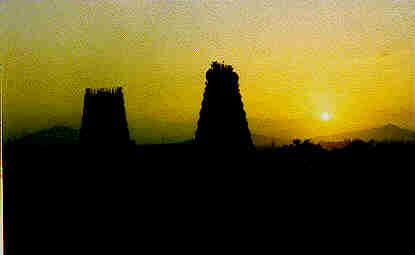 | A panoramic and dramatic view of the temple complex at Madurai in Tamil Nadu. |
All this whi1e being generally true, leads to notions that everything associated with Hinduism originated in India, which is, strictly speaking, incorrect. Hinduism has borrowed significantly from other religions although this has not been a one way affair.
We shall see below how Hinduism has much more significantly lent to other religions than it has borrowed from them.
To understand the fusion of customs and beliefs of different religions we shall review the history of these religions in the folowing chapters.
We first turn our attention to the second great religion that emerged from ancient India - Buddhism. This religion was also the first to institutionalize missionary activity and to reach global dimensions in the ancient period circa 300 B.C.E.
_____________________________________________________________
____________________________________________________________________
| _ _ _ |
_____________________________________________________________ ___________________________________________________________
|
_________________________________________________
We invite you to participate in an online chat in our Hindu History Chatroom.
___________________________________________________
_________________________
Other relevant sites
Hindu World
HinduNet
HinduWeb
Hindu Hriday Samrat
Hindu Books
Hindu Literature
HindutvaNet
Hindu Vivek Kendra
Hindu Students Council
RSS
VHP
________________________________________________
________________________________________________